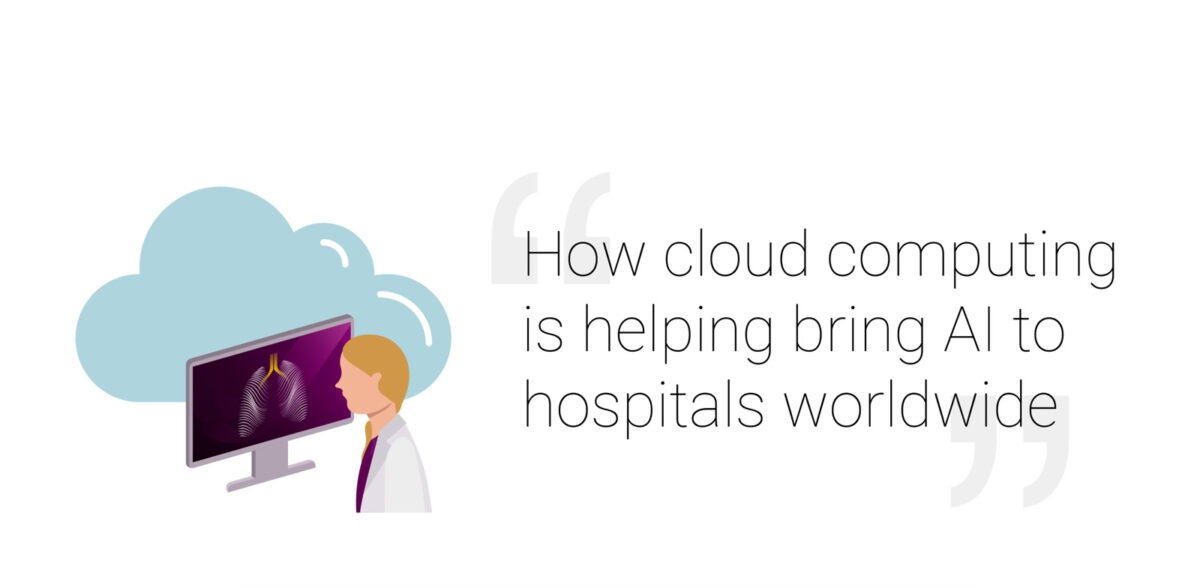What do you know about cloud computing and its role in healthcare settings? In this article, Sham Sokka, Chief Operating and Technology Officer, DeepHealth explores how cloud computing is helping hospitals to adopt new AI technologies that enhance patient care.
What is cloud computing?
The term ‘cloud computing’ can be misleading. Coined when the technology was first developed, it suggests something abstract and intangible. However, the term ‘cloud’ is a specific reference to series of technology services offered over an internet connection. Examples you may have come across include iCloud, an extension of an iPhone’s physical storage, which uses data from Apple’s servers. The extra storage is provided by an offsite data center – so it does physically exist.
Cloud computing offloads data from self-managed technological devices to partners who can offer scalability, expertise and efficiency. It is often referred to as infrastructure as a service (IaaS). From retail to real estate, most industries use cloud computing or are moving towards it. This includes risk-sensitive organizations such as banks or the US National Security Agency, which has now moved all its data to cloud.1
How does DeepHealth use cloud computing?
At the heart of DeepHealth’s portfolio is a pioneering cloud-native operating system (DeepHealth OS) that unifies data across the clinical and operational workflow and personalizes AI-powered workspaces for everyone involved in the radiology continuum, enabling them to deliver better care, driving value across the enterprise, while facilitating the clinical and technological adoption of AI tools.
Transitioning to a cloud-native system allows DeepHealth to enhance scalability, leverage cloud-based data services and incorporate state-of-the-art monitoring and security infrastructure, as well as to bring lower-cost, robust, and secure workflow improvements to more imaging centers and health systems.
The cloud-native system enables IT teams at hospitals and imaging centers to streamline operations, freeing up time previously spent on error resolution, study routing, data center management, and hardware maintenance and upgrades.
For radiologists, DeepHealth’s adoption of a cloud-native system facilitates a hybrid on-site and remote work model, eliminating locational constraints and enabling more physicians to access and review images from anywhere. This flexibility alleviates the burden of physical presence and staff shortages, allowing experts to collaborate effectively and adaptably.

In summary, cloud-based OS systems enhance efficacy and efficiency by seamlessly integrating disparate teams, reducing IT overhead, and offering location flexibility to radiologists.
Cloud computing provides efficacy.
DeepHealth’s AI tools have shown efficacy in real-world clinical settings. In exploratory studies, limited to several Mid-Atlantic practices, DeepHealth’s clinical AI tools have shown the potential to improve cancer detection rates by as much as 20% and reduce false positives by up to a third.
As a wholy-owned division of RadNet, the company has become a trusted partner to radiologists globally, with its technology used in over 300 radiology departments and imaging centers in select countries. Over fifteen million exams are performed annually using DeepHealth solutions, resulting in more than two million AI-informed diagnoses.
Ensuring healthcare providers have the latest AI offering quickly and easily.
The cloud offers easy maintenance and frequent upgrades. These are available to physicians and their patients immediately; for example, when we release new services, they can be tested and activated in hospitals as soon as they need them, without having to wait for physical devices to be shipped, received, built, tested, and installed. A process that used to take months can now be completed in one morning.
Random events, such as weather, can have a serious impact on patients if surgery is underway at the time. Using cloud services reduces the risk of such events affecting hospital data; the cloud streamlines redundancies of software and data placing less of a burden on hospital IT systems.
Safer than alternative data storage methods.
In over 20 years of working in healthcare technology, a question I’ve frequently been asked is: “Is this new technology safe for patients”?
For healthcare professionals, patient safety is always the priority. They want to be sure they have control over their facility’s health data and that no vendor or third party can access it – after all, it’s their responsibility to protect their patients.
We take security very seriously. As a global organization, DeepHealth is dedicated to maintaining the highest standards of patient data protection, always staying abreast of the changing regulatory requirements across the countries we operate within.
In fact, the cloud increases the security of a small or midsized company like DeepHealth; for example, it gives us access to cloud providers’ ability and resources with top-of-the-line security tools and practices. What’s more, we use additional cloud services for additional layers of security.
Cloud vendors have standardized and transparent agreements for data processing and storage, meaning that they cannot access our data. In addition, we can encrypt the data both at rest and in transit to ensure it remains secure even in the case of a malicious attack.
We use data centers close to our customers and respect the data rules and regulations of each country in which we operate. In compliance with regulatory requirements, the data never leaves the area where processing or storage is allowed (e.g., EU data never leaves the EU block).
Using the cloud to deploy the DeepHealth OS in a safe, cost-effective, and accessible manner has freed up our time to focus on our key mission: empowering breakthroughs in care delivery.
1 https://www.nextgov.com/emerging-tech/2018/06/nsa-systematically-moving-all-its-data-cloud/149179/






